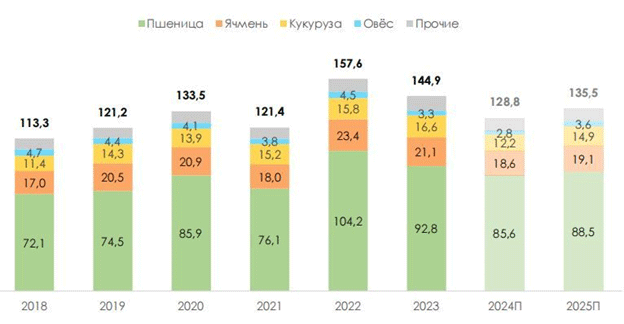Russia’s grain industry has shown remarkable growth over the past decade. In 2023, a record-breaking 145 million tons of grain was harvested, including 93 million tons of wheat, which represented 64% of the total grain yield. Barley and corn followed, with 21.1 million and 16.6 million tons, respectively. This significant yield was driven by favorable climate conditions, government support, and advanced agritech, ensuring domestic sufficiency and creating export surplus.
However, 2024 brought challenges. With adverse weather—including spring frosts, summer droughts, and heavy rainfall during harvest—grain yields decreased. By October 2024, 122 million tons of grain were harvested, a 10% reduction from the previous year, with wheat comprising 86 million tons. Total 2024 production is expected to decline by 11%, reaching around 128.8 million tons. Despite this reduction, internal demand remains well-supported.
Rising Domestic and Export Prices
The grain market has faced notable price fluctuations. Following a record 2022 harvest, high carryover stocks led to a supply surplus in 2023, driving down prices by 23% year-over-year. But in 2024, with global prices rebounding and Russian supplies moderating, domestic wheat prices have begun to rise. By the third quarter, wheat prices had recovered to approximately 12,700 RUB per ton, a 17% year-over-year increase. Barley and corn prices similarly saw double-digit gains.
On the export side, Russian wheat (12.5% protein, FOB) was trading at $216-220 per ton in September 2024. Climate phenomena like El Niño have caused adverse weather conditions across key grain-producing countries, reducing global wheat supplies to a nine-year low, according to the U.S. Department of Agriculture. This tightening supply is forecasted to drive Russian export prices up by 5.3% for wheat, 8% for barley, and 12.5% for corn by year-end.
Export Potential and Friendly Market Expansion
Russia remains one of the world’s largest grain exporters, having exported a record 66.6 million tons of grain in 2023, predominantly wheat. Despite challenges, Russian grain is increasingly in demand from Middle Eastern, African, and Eurasian Economic Union (EAEU) nations, including Kazakhstan, Belarus, and Kyrgyzstan, which saw a 44% import increase in 2023. Russia’s export strategy is also increasingly targeting non-Western markets, with demand growing in countries such as Brazil, Tanzania, and Vietnam.
In 2024, exports are expected to reach 70 million tons, and while 2025 may see a slight reduction due to lower yields, the demand in EAEU and African markets should continue to drive Russian exports. Major buyers like Egypt and Turkey have scaled back, while Nigeria and other African countries have increased imports, indicating a shift in Russia’s trade dynamics.
While the Russian grain market shows resilience and stability, various factors suggest rising prices for wheat. Despite the reduced harvest in 2024, the combination of strong domestic demand, tighter global supplies, and favorable export potential indicates that Russian wheat prices will likely continue to climb, especially as climate disruptions worldwide impact global grain stocks. Russia’s ongoing commitment to serving friendly markets will help strengthen its position as a leading wheat exporter, even as the global grain landscape becomes increasingly competitive.
Error





